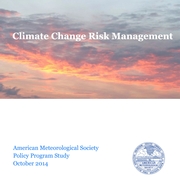Key Findings and Recommendations
As a public and policy issue, climate change boils down to four overarching issues: 1) climate is changing; 2) people are causing climate to change; 3) the societal consequences of climate change are highly uncertain but include the potential for serious impacts; and 4) there are numerous policy options for climate change risk management, most of which are well characterized (i.e., have known strengths and weaknesses). These four conclusions are based on comprehensive assessment of scientific understanding and each is the result of multiple independent lines of evidence.
Climate change risk management approaches generally fall into four broad categories: 1) mitigation—efforts to reduce greenhouse gas emissions; 2) adaptation—increasing society’s capacity to cope with changes in climate; 3) geoengineering or climate engineering—additional, deliberate manipulation of the earth system that is intended to counteract at least some of the impacts of greenhouse gas emissions; and 4) knowledge-base expansion—efforts to learn and understand more about the climate system, which can help support proactive risk management.
By reducing emissions, mitigation reduces society’s future contributions to greenhouse gas concentrations in the atmosphere. Ultimately, this can help reduce the amount that climate will change and thereby increase the potential that societal impacts will remain manageable. Approaches to reducing emissions fall into several categories. These include 1) regulation; 2) research, development, and deployment of new technologies; 3) conservation; 4) efforts to increase public awareness; 5) positive incentives to encourage choices that lower emissions; and 6) adding a price to greenhouse gas emissions, which creates incentives to reduce emissions broadly.
Adding a price to greenhouse gas emissions is a particularly noteworthy policy option because it would be expected to have a broad-reaching impact on emissions; it has received a great deal of attention from the research community; and it has been a focus of policy discussions since climate change emerged as a public issue.
Adaptation involves planning for climate impacts, building resilience to those impacts, and improving society’s capacity to respond and recover. This can help reduce damages and disruptions associated with climate change. Adaptation policy can include regulation to decrease vulnerability (e.g., through land-use planning and building codes); response planning; disaster recovery; impact assessment for critical systems and resources (e.g., water, health, biological systems, agriculture, and infrastructure); observations and monitoring; and efforts to minimize compounding stresses such as traditional air pollution, habitat loss and degradation, invasive species, and nitrogen deposition.
Geoengineering refers to deliberate, often global-scale, manipulations of the climate system. Two categories of geoengineering are most prevalent within scientific and policy discussions: solar radiation management (offsetting human-caused warming due to greenhouse gas emissions by reflecting incoming sunlight back to space) and carbon removal and sequestration (extracting carbon dioxide from the air and storing it deep in the ground or ocean).
Geoengineering could potentially help lower greenhouse gas concentrations in the atmosphere, counteract the warming influence of increasing greenhouse gas concentrations, address specific climate change impacts, or offer desperation strategies in the event that abrupt, catastrophic, or otherwise unacceptable climate change impacts become evident. Geoengineering could also create new sources of risk because attempts to engineer the earth system on a large scale could lead to unintended and adverse consequences.
Research, observations, scientific assessments, and technology development can help reveal risks and opportunities associated with the climate system and support decision-making with respect to climate change risk management. Expanding the knowledge base allows policy makers to understand, select, and refine specific risk management strategies and to thereby increase the effectiveness of risk management efforts. Knowledge-base expansion can, in some cases, also reveal entirely new opportunities for protecting the climate system or reducing the risks of climate change impacts. As a result, policies to expand the knowledge base can underpin and support the proactive risk management strategies described above (mitigation, adaptation, and geoengineering).
None of the risk management options is mutually exclusive. Indeed, comprehensive climate change risk management almost certainly includes a combination of policy responses. However, policy choices necessarily integrate both objective information about the climate system and our relationship with it, and subjective value judgments such as whether we are more averse to the risks of changes in climate or the policy responses, the ways we assess issues of fairness among nations and peoples, and the consideration we give to cultural heritage or nonhuman species. This creates a complex and often contentious risk management challenge.
